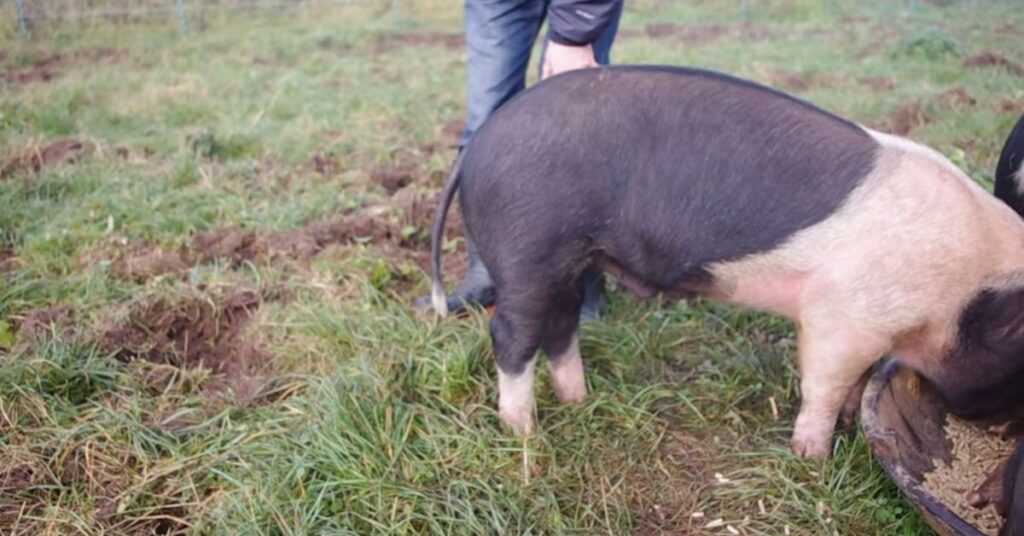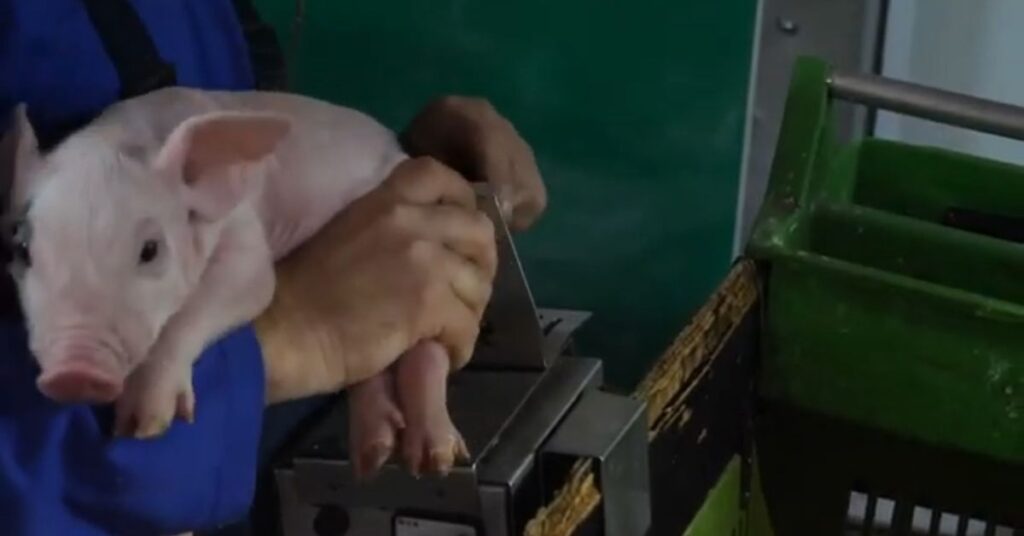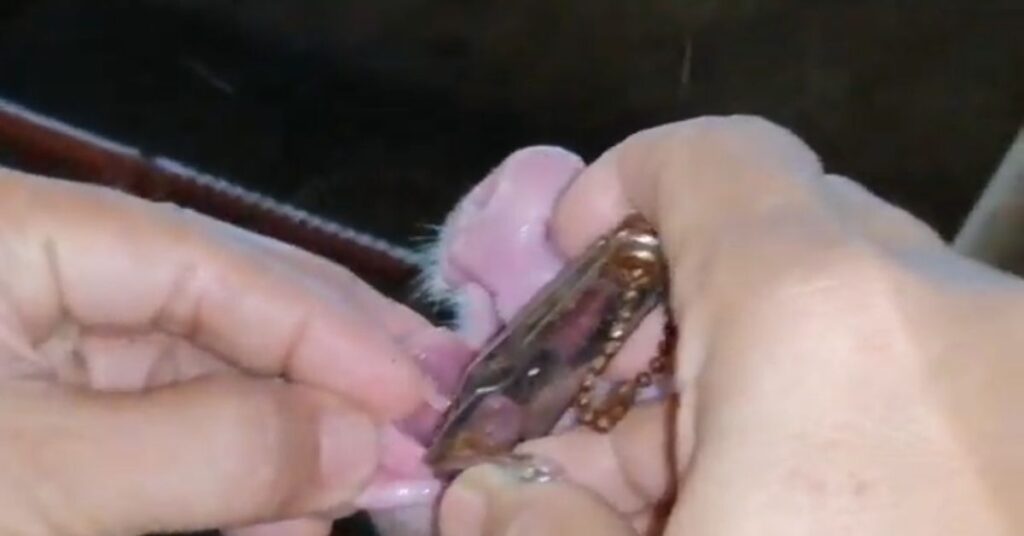Pigs are becoming increasingly popular as pets. With their intelligence, sociability, and charm, more and more people are welcoming pigs into their homes. As pig popularity rises, interest in their unique features – like their curly tails – also increases.
Curly tails can be found on many breeds of domestic pig but are not common in wild pigs. This has led many to wonder – why do pigs have curly tails?
In this comprehensive guide, we will explore the leading theories behind curly pig tails, look at pig breeds with curly and straight tails, and learn about pig communication and welfare.
Theories Behind Curly Pig Tails
While there is no definitive scientific explanation for why domestic pigs evolved to have curly tails, there are some leading theories.
Accidental Trait from Selective Breeding
One theory is that curly tails were an accidental consequence of selective breeding. Humans have been raising pigs for over 9,000 years and have selectively bred them for desired traits like size, temperament, and meat quality. This intensive breeding may have led to genetic mutations like curly tails.
Selective breeding is known to cause unintentional changes in animals. For example, many dog breeds suffer from genetic problems due to selective breeding. As humans bred pigs for agricultural purposes, curly tails may have emerged as an inadvertent trait.
Protection Against Tail-Biting
Another popular theory is that curly tails evolved to protect pigs from tail-biting injuries. Pigs in close confinement will often bite each other’s tails, which can cause injury and infection. It’s hypothesized that curly tails made it harder for pigs to get a firm bite, providing protection.
This theory proposes that curly tails were naturally selected for in domestic pigs. Pigs with straighter tails were more likely to experience injury, while curly-tailed pigs had an advantage. Over many generations, curly tails prevailed as pigs with that trait were healthier and produced more offspring.
Chinese Pig Fighting
There is also a theory that curly tails arose in China through pig fighting. For centuries, pig fighting has been a popular sport in rural China. Pigs naturally bite at each other’s tails during fights. The thinking is that pigs with curly tails were better able to avoid tail bites, making them more successful fighters. China has long valued pigs with curly tails and some believe this fighting history is why.
Intentionally Selected Trait
Some speculate that pig farmers intentionally selected for curly tails. There is a long-held belief (with limited scientific evidence) that curly tails indicate health in pigs. Farmers may have actively bred pigs with curly tails, believing it was a desirable trait connected to health and vigor. This could have contributed to the prevalence of curly tails in domestic pigs today.
While the origins remain uncertain, one or more of these factors likely contributed to the evolution of curly tails in pigs. More scientific research is needed to understand the history behind this unique physical feature. The prevalence of curly tails does appear strongly linked to domestication, as wild pigs typically have straight tails.

Pig Breeds With Curly Tails vs. Straight Tails
Many domestic pig breeds have curly tails, though straight tails also occur. Whether a pig breed has curly tails or not depends on its origins and the purpose it was bred for.
Breeds With Curly Tails
Here are some common domestic pig breeds that typically have curly tails:
- Duroc – Developed in the US from British and Iberian lines, Durocs are a popular red pig breed raised for meat.
- Berkshire – An old British breed valued for its flavorful meat. Berkshires are black with white feet.
- Large White – A white pig originating from England, also called Yorkshire. Used for meat and crossbreeding.
- Hampshire – Black pigs with a white belt, originally from England. Known for lean, high-quality meat.
- Pietrain – A Belgian breed with very lean, heavily muscled bodies, making it a popular terminal sire.
- Landrace – A Danish breed noted for large litters of piglets. Used in many crossbreeding systems.
The list goes on. Many heritage breeds from the British Isles and northern Europe have curly tails. These pigs were traditionally bred for farming purposes like meat, lard, and hardiness.
Breeds With Straight Tails
Some domestic pig breeds have straighter tails, including:
- Potbellied – A small Asian breed kept as pets. Most have straight tails.
- Mulefoot – An old American hog with solid black hooves like a mule. Has a straight tail.
- KuneKune – A small pet pig originating in New Zealand, can have straight or slightly curled tails.
- Meishan – A highly prolific Chinese breed. Most Meishans have naturally straight tails.
Pig breeds developed for specific purposes like pets, research, or novelty tend to have straighter tails. Heritage breeds closer to wild boars, like the Mulefoot, also often have straight tails.
So while curly tails prevail in modern production pigs, straight tails do exist in certain breeds. Even in curly tailed breeds, some individuals are born with straighter tails depending on their genetics.
What Does a Straight Tail Signify?
A pig’s curly tail going straight can communicate important information about their wellbeing. Farmers have long observed that when pigs are stressed, ill, or in an unpleasant environment, their tails straighten and hang down limply.
Research has confirmed this observation. A 2020 study published in Animal Welfare looked at the tails of pigs living in different environments. Pigs in barren, crowded pens had predominantly straight tails. But when provided with ample space, enrichment, and social partners, their tails became curly again.
A straight tail can signal that a pig is unwell or distressed. Possible reasons include:
- Illness, injury, or pain
- Poor diet lacking proper nutrition
- Overcrowding and lack of stimulation
- Aggression from other pigs
- Uncomfortable temperatures – too hot or cold
- Fear, boredom, isolation, or other psychological issues
In these situations, a pig’s tail loses its natural curl and hangs straight. This useful indicator allows farmers to identify pigs in need of medical care, diet improvements, or environmental changes. For pet owners, it signals that your pig may need some TLC!

Why Don’t Wild Pigs Have Curly Tails?
The tails of wild pigs (boars) are almost always straight. So why did curly tails emerge in domestic breeds? There are a few possible explanations:
Stressful Living Conditions – Life in the wild is a constant struggle for survival. Wild boars deal with food uncertainty, competition, predators, and unpredictable weather. Their straight tails may reflect near-constant stress.
Neutral Tail Position – A straight tail could be the natural neutral position for pigs not experiencing stress or joy. Without selective breeding, there was no preference for curly tails.
Lack of Confinement – Wild pigs roam freely and don’t face the same social pressures as confined domestic pigs. With open space and stable groups, there are fewer reasons for pigs to bite tails.
No Human Intervention – Straight tails prevail in wild pigs because humans did not intentionally breed for curly tails. The curly trait only emerged through domestication.
So while a straight tail can signal stress in domestic pigs, it is simply the natural state for wild boars. Without selective breeding or unnatural living conditions, straight tails persist in the wild.
Do Mini Pigs Have Curly Tails?
Many prospective pet pig owners wonder – do mini pigs have curly tails too?
Mini pigs usually belong to two main breeds – the Potbellied pig and KuneKune pig. Most Potbellies have naturally straight tails. KuneKunes can have slightly curled tails, but not to the degree seen in commercial pig breeds.
Some mini pigs may have curly tails if they come from crosses with commercial breeds or curly-tailed heritage breeds. But since most popular pet pigs derive directly from Potbellies or KuneKunes, straight tails are the norm.
So while their commercial full-sized counterparts have pronounced corkscrew tails, mini pigs tend to have straighter, minimally curled tails. Some may even have tails as straight as a wild boar! But no matter how their tail curls (or doesn’t), mini pigs make delightful pets.
Tail Docking and Clipping in Pigs
To understand why some domestic pigs have such curly tails, it helps to know about two common piglet procedures – tail docking and tooth clipping.
Tail Docking
Tail docking involves surgically shortening a young piglet’s tail, usually performed within the first week of life. There are two main reasons farmers dock tails:
- To prevent tail biting later in life. Pigs in confinement will often bite each others’ tails, causing injury. Docking reduces tail length to make this harder.
- To prevent feces and mud from clinging to tails. With shorter tails, pigs stay cleaner.
Docking is controversial, as it causes pain to piglets and shortens a useful part of their body. But many producers continue the practice to avoid tail injuries and issues.
Pigs with docked tails retain enough of a tail to continue communicating, but not enough length to easily bite. Docking may have contributed to increased tail curling in some breeds, since stubs are harder to straighten.

Tooth Clipping
Piglets are born with sharp teeth that they use to establish a teat order when nursing. If left intact, these teeth can cause serious cuts and injury to the sow’s teats and udders.
To prevent harm to sows and reduce fighting among litter-mates, producers clip or grind down the tips of piglets’ eight sharp front teeth. This is done when they are around 1-7 days old.
Clipping reduces teeth sharpness but allows the piglets to continue nursing normally. Like docking, this procedure is painful but considered necessary by many in the pork industry.
Understanding docking and clipping provides insight into why extreme curly tails have persisted in domestic pigs. With tails shortened at birth and competition limited by tooth dulling, there was less evolutionary pressure for straight tails.

Reading a Pig’s Tail
A pig’s curly tail is useful for communicating their emotional state. Here’s what a pig’s tail can tell you:
- Limp, hanging straight down – The pig is sick, stressed, or uncomfortable
- Stiff and rapid wagging – The pig is irritated or feeling threatened
- Loose, wide wagging – The pig is excited about something or happy
- Raised straight up – The pig is testing the social situation or curious
- Held curled – The pig is content and feeling secure
- Tucked away – The pig is anxious, nervous, or fearful
Pig owners should observe tail positions and motion to better understand their pet’s needs and emotions. A limp tail means assessing their environment, while active wagging can signify if a pig is in a positive or negative state.
Learning your pig’s tail language takes time but allows you to keep them healthy and happy.
Pig Tail FAQs
Are curly tails related to pig health?
There is limited scientific evidence that curly tails are linked to health. Some speculate pigs with curly tails were heartier, but this has not been proven. Tail curl indicates mood, not necessarily overall wellness.
Why do pigs wag their tails?
A pig wags its tail to communicate strong emotions. Wide, vigorous wagging signifies excitement and joy. But rapid, stiff wagging indicates irritation or protest. Pigs may also wag tails in social greeting.
Do all baby piglets get their tails docked?
The majority of commercial pig farms dock tails to help prevent injury. But small, niche farms may choose not to dock. Pet and potbelly pigs typically keep their full, natural tails.
Does tail docking hurt the pig?
Yes, tail docking causes pain to the piglet. Though it is done early in life, the piglet still experiences physical discomfort during and after the procedure.
Are curly tails related to better meat quality?
There is no evidence that curly tails are linked to superior meat quality. Tail shape is not known to affect pork flavor, texture, or nutrition in any way.
Can you predict litter size by the sow’s tail?
No, there is no reliable way to estimate litter size by looking at a sow’s tail. Litter size is determined by the individual female’s reproductive biology.
What is the purpose of a pig’s tail?
A pig’s tail serves several purposes:
- Balance and coordination when moving
- Expression of emotions through position and motion
- Defense against flies and bugs
- A means of social communication with other pigs
- Visual indicator of the pig’s health and wellbeing
Conclusion
While the origins are still uncertain, curly tails have become a signature trait of domestic pigs. They likely arose during early selective breeding or due to conditions pigs faced when confined together. Regardless of how they evolved, curly tails continue to fascinate pig enthusiasts today.
A pig’s tail can provide valuable insight into their mood and wellbeing. Curled over, active wagging reflects a happy pig. But watch for tails hanging straight down, signaling an issue may be present. Getting to know your pig’s unique tail language will help you better care for them.
Pigs make marvelous pets, with curly or straight tails. As more folks welcome pigs into their families, appreciation grows for their many quirks…including their adorable curled tails.
References:
